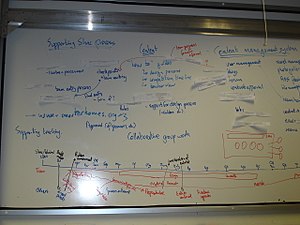Creating effective business presentations/Developing business presentations/Planning, research and organization
| “ | Planning is bringing the future into the present so that you can do something about it now. | ” |
| —Alan Lakein | ||
Read Chapter 10 Introduction, Section 10.1 Before you choose a topic, Section 10.2 Choosing a topic and
Section 10.3: Finding resources, in Saylor Academy (Ed.) 2012. Business Communication for Success. (See page(s) 370 - 401 in PDF version.). Don't worry about any of the section exercises at this stage.
When planning to give a presentation, we usually begin by thinking about the purpose of the presentation. This includes both general and specific purposes.
The five general presentation purposes are to inform, persuade, demonstrate, entertain, or perform a ceremonial function. The specific purpose involves the content and context of the presentation.
Next, we need to find out about our
- target audience,
- topic, and
- time allocation.
When these things are clear, it should then be possible to state the objective of our speech in one sentence.
Key strategies to help select and narrow your topic effectively include
- assessing your abilities,
- knowing your audience, and
- thinking about topic appeal and appropriateness, and
- managing your time well.
You will also need to think about how to make your topic interesting and relevant to your target audience in ways that support your general purpose.
The final section here (section 10.3) describes how to focus on your key presentation points, plan, and organise your information search, evaluate your sources for reliability and credibility, and practise ethical communication.
Later in the course, you will be challenged to create and deliver an audience-centred informative presentation, on a business topic of your choice. Authentic communication is crucial to engaging people. If you are truly interested in your topic, and provide credible information, you will probably generate audience interest too.
The College of Dupage Library Information Literacy webpage offers many other openly licensed research resources, including topic identification, finding evidence, and evaluating sources worksheets. The Topic Identification worksheet has a section for tracking different kinds of resources as you build your presentation. Their Tips for Evaluating Information worksheet and Evaluating Sources video are also useful resources.
Choose a topic that you might be asked to give a short presentation on (or use one that you are already working on), in which your general purpose is to persuade. Search for some resources you think would be useful. As you are looking for resources, reflect on the following questions:
- How do you decide if the resources are relevant and reliable?
- How do you choose which information you need to include, and what you can leave out?
- Can a persuasive speech still be be ethical? If so, how? Explain your thinking and give some examples.
Add this reflection to your learning journal. Be sure to label or tag your post ccom102.
